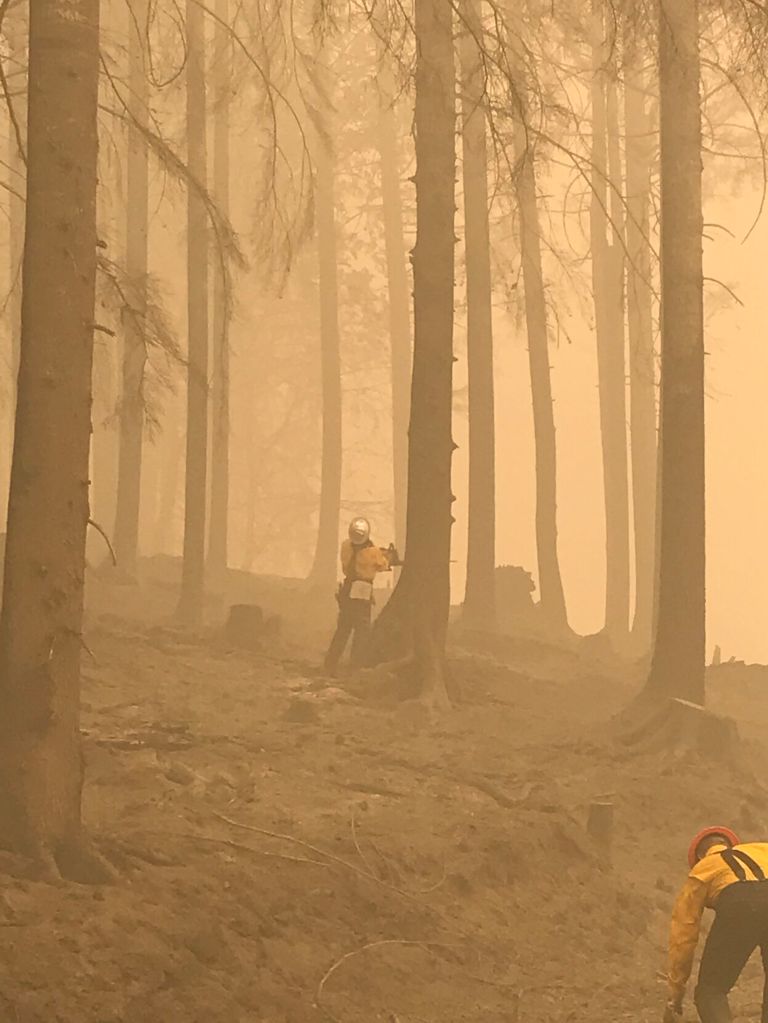Wildfires scorch logging companies
Published 4:00 am Thursday, October 29, 2020
MARCOLA— Sweet Home native Lucas Hufford, 39, is a fourth-generation logger.
His family owns Timberline Logging and although they weren’t among the community’s founders, the clan has been in the Sweet Home area long enough to claim a geographic namesake — Hufford Ridge east of town.
His grandfather, Tom Hufford, drove log trucks until he was 88 years old and founded the popular Grampa Tom’s Car Show that attracted hundreds of custom cars every summer for many years.
His father, Ted Hufford, was a key figure in the timber wars of the 1990s.
Lucas Hufford has experienced the highs and lows of the profession all of his life.
But the 173,000-acre Holiday Farm Fire that started Labor Day evening and is contained but still burning threatened more than just Hufford’s livelihood. The blaze also destroyed more than $2 million in logging equipment while coming within a mile of the home he and his wife, Jessica, occupy a few miles south of the Linn-Lane county line off Marcola Road.
“I got a phone call about 5 a.m. Tuesday (Sept. 8) from Jeremy Norby of Guistina Resources,” Hufford said. “He said, ‘Don’t be a hero! This thing is moving really fast.’”
Two hours later, Hufford learned that his logging equipment had been destroyed, except a 1,000-gallon fire truck, which he moved to a friend’s property near Sweet Home.
Hufford said he was surprised by the call. Employees had contacted him on Labor Day and told him high winds were buffeting the area.
“It was completely calm here,” Hufford said. “I took a video to show them how nice it was.”
“I called Jess at work and told her to not come home because I knew the fire had to be close to our home,” Hufford said. “I started putting important stuff like pictures, paperwork and guns into my truck because I didn’t know if we would have anything left in a few hours.”
For several days, it was touch and go for the couple, not knowing whether the fire — which got within one mile of their property — would continue marching toward them or be redirected by winds. They stayed with family and friends for a few nights.
“I was on the phone constantly with folks from Guistina, Cascade Timber Consulting and Weyerhaeuser,” Hufford said. “And then my crew got called to help fight fires. We have eight guys counting myself and most have been with us a long time.”
Hufford said the fire set his company back 30 years in terms of equipment.
“We lost our best, newest and fastest equipment,” Hufford said. “Our yarder was a 1999 and was 70 feet tall. Now, we’re using a backup that was made in 1987 and is 50-feet tall. It’s OK as a backup, but it’s pretty old to be using every day.”
A new yarder costs about $1.2 million, plus another $10,000 for rigging.
Also lost was a stroker, valued at $500,000, a shovel (excavator) valued at $400,000 and a sky car valued at $100,000.
“Now, we don’t have any backup equipment,” Hufford said. “We have insurance, but we are waiting to hear how that plays out. It will probably take six to eight weeks to get it figured out. This could put us out of business, but I think we will survive.”
On the fire lines
Hufford said his crew was off work for a couple days and then they got called to help fight fires.
“Nobody knew what was going on those two days,” Hufford said.
Hufford’s crew fought the fire for seven days on property owned by Campbell Global above Cougar Reservoir.
“It was so smoky,” Hufford said. “We were on the front line of the fire and at one point, we were told to ‘get out now.’”
Hufford said that Brett Graham of Sweet Home brought in a bulldozer and cut several miles of fire line. Hufford said the fire kept producing sparks or embers that were carried by the wind to start new fires. His crew worked from his 1,000-gallon fire truck.
Hufford said that in addition to the loss of equipment, huge log decks were destroyed.
“Nobody thinks about that, but there were lots of logs that had already been harvested and were decked up waiting to be hauled,” Hufford said. “Lots of hours went into building those decks and they were worth a lot of money.”
Hufford said he isn’t sure if he will be paid for that loss.
“The cutters who felled the trees also don’t know if they will get paid,” Hufford said.
Hufford said he has considered “getting out of logging,” but he doesn’t know what he would do instead.
“A lot will depend on whether we will be allowed to salvage the trees,” Hufford said. “There is a two- to three-year window to do that. There’s also the long-term question of whether there will be enough seedlings to replant since there have been about seven million acres burned in California, Oregon and Washington.”
Hufford said that even when the fire is deemed out, it may be difficult to work.
“Our yarder needs strong trees or stumps to anchor to so it won’t tip over,” Hufford said. “And, for cutters and choker setters, there is no underbrush to hold rocks and stuff from sliding. This winter, rain could make things really slick since there isn’t any grass left.”
The cause of the Holiday Farm Fire remains unknown, but at its peak, the fire had a 260-mile perimeter. The blaze consumed more than 500 structures. The Holiday Farm Fire was one of three major fire complexes that started on Labor Day.
The Beachie Creek Fire that began in the Opal Creek Wilderness Area and the Lionshead Fire that was blown into the Santiam Canyon from Central Oregon devastated the towns along the North Santiam River at the same time the Holiday Farm Fire was blasting Linn and Lane county.
Freres battles back
The Freres family has operated mills and tree farms for nearly 100 years in the Lyons area. They lost 7,500 acres of timber lands, but according to company president Rob Freres, did not lose any logging equipment, although contractors working for them did.
“The owner of Skycar Logging lost three pieces of equipment,” Freres said. “He is of retirement age and decided to not purchase new equipment, but another company lost a couple pieces of equipment, ordered new equipment while the fires were still burning and has already received them.”
The Freres family has operated businesses in the Santiam Canyon since 1922 and posted a message on the internet that they plan to begin salvage logging immediately.
“We are putting seven logging sites into company grounds this week and next,” Freres said. “We plan to stay there this year and into the next.”
Freres said there is a two-year window to salvage the burned timber. The company plans to harvest as much as it would typically harvest in a year’s time in the next few months.
It is important to harvest quickly, the company notes because the prime wood retains its quality for just a short time.
There are issues with burned wood, Freres notes:
• Over time, the woody materials could deteriorate to the point it would “reduce the grade out of our veneer products.”
• Burned wood products need to be separated from unburned products because chip customers cannot process burned materials.
• Bark from smaller logs could be used in the company’s power generation plant, but larger bark can be used in nursery bark.
Industry losses
Rex Storm, executive vice president of Associated Oregon Loggers, estimates companies lost $100 million due to the fires, about 40% in destroyed equipment.
“Everyone thinks about the burned-up equipment, but there was so much more including lost income due to idling time, moving equipment and access to capital,” Storm said.
Storm said companies must continue to pay equipment and tax payments even though they aren’t generating income.
“Think about a pizza shop owner. He makes his living making and selling pizzas, but what if there was a fire and he couldn’t make pizzas anymore, but also had to move all of his equipment to a warehouse and then move it back after everything clears up,” Storm said.
“And, while capital is always an issue for small businesses, now, it’s even more critical and will likely cost more in terms of interest rates. The same is true for equipment, which will be at a premium, since so many people will need the same pieces to rebuild.”
Storm said the fires impacted trucking companies and tree growers as well.
He added that rural communities are used to adversity and will rebuild.
“Everybody wants to focus on the losses, but rural communities and small businesses are resilient and have suffered damage before. They have risen to the occasion and have rebuilt,” Storm said. “It will take time, but they will rebuild. Forest communities will rebuild and our forests will be rebuilt as well.”







